When hearing the phrase “growing grapes in Siberia,” many gardeners smile incredulously. Many are sure that growing southern plants in such harsh climatic conditions is simply impossible. So, is it true or a myth to grow and obtain a full harvest of grapes in Siberia? How can one explain the statement that it was the Altai grape harvest that was of key importance for Siberia? Should novice gardeners be afraid of growing grapes in Siberia? In this article we will try to answer these and many other questions that concern gardeners in Siberia.
Features of growing grapes in Siberia
It took a long time to successfully grow grapes in Siberia. Gardeners have repeatedly encountered such difficulties when trying to get a grape harvest, such as:
- the grapes could not withstand the harsh winter conditions and just froze;
- early autumn frosts completely destroyed the newly emerging summer growth;
- after removing the cover in the spring, when the buds began to bloom, unexpected frosts could easily come, which would also deprive the long-awaited harvest.
Another reason why for a long time was not in Siberia successful experience growing this crop was due to the inexperience of the gardeners themselves in this matter. They simply used “southern” agricultural technology, which was fundamentally unsuitable for the climatic conditions of Siberia with its harsh winters. The long-awaited success, which became a turning point in Siberian viticulture, was achieved by agronomist V.K. Nedin. He collected an excellent grape harvest in Altai, which in its quality was not inferior to the “southern” harvests. Repeated success occurred later, in Biysk. There they began not only to successfully grow grapes with full clusters, but also began to cultivate different varieties with different taste characteristics, shape and color. Based on this positive experience, 2 reliable and effective systems for Siberian viticulture were gradually developed.
Siberian viticulture system No. 1
- Seedlings should be stored in frost-free rooms in winter or in dug trenches at least 1 meter deep.
- Graft early grape varieties with a shield onto rootstocks of winter-hardy American or Amur grapes. This cunning technique will protect the roots of the grapes from freezing in harsh winters with little snow cover.
- When planting seedlings, make the planting holes deep enough, except in areas with high groundwater flow. Fertilizer must be applied to the bottom of the pit. This method of planting will also protect the grapes and their roots from surface freezing.
- Do not tie up the grapes and do not determine the final load on the bush in the inflorescences until the spring frosts are definitely over. During periods of frost, cover the grapes with rags or film.
- Perform a minimum of pruning and tying in the summer.
- "Hard" grape growing in Siberia. You should not do any fertilizing or spraying, because... In Siberia, there are practically no serious grape pests or diseases. It will be enough to remove weeds around the plant and mow the grass between the rows.
- To obtain the richest harvest possible in Siberian conditions, the bush should be formed on a vertical wire trellis in a cardio-radial form.
- Autumn pruning of grapes in Siberia differs from pruning in the southern regions: the load on the eyes and shoots should be 2 times greater than in the “southern” pruning technique. It is recommended to carry out pruning in 2 stages: before September and before covering for the winter.
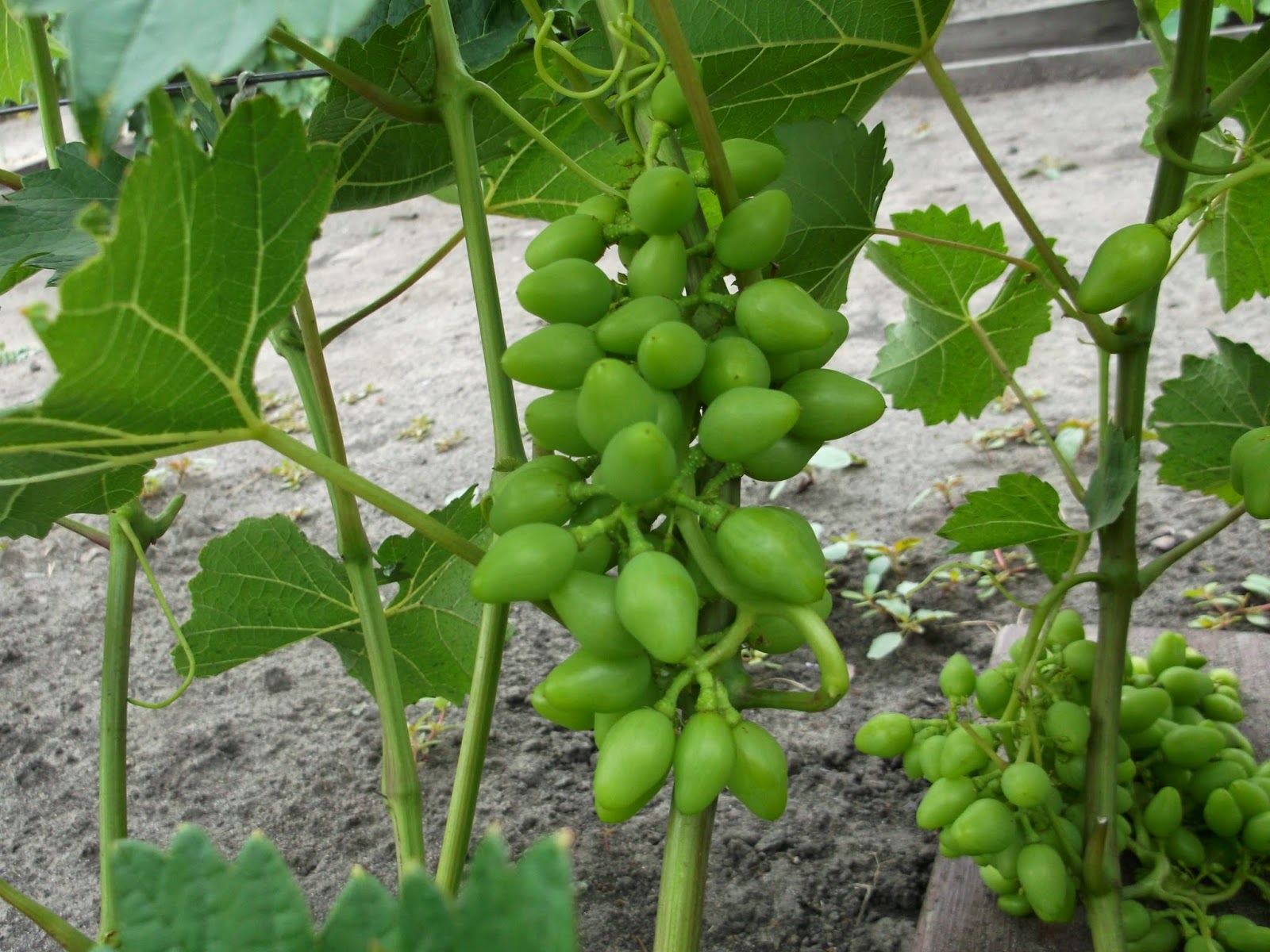
Siberian viticulture system No. 2
- Grapes in Siberia do not require grafting onto winter-hardy rootstocks. In the fall, cuttings are prepared. It is better that they are the right size right away. They should be stored either in the cellar or together with the “mother” bush, covered for the winter.
- If grapes are grown on chernozem soil, then a planting hole is not necessary. If on sandy, clayey, poor soils, then a planting hole and the introduction of fertilizers into it are necessary.
- Growing grapes also uses “harsh” technology. There is no need to perform any fertilizing, spraying, loosening, etc. The grapes will only need weeding from weeds and maintaining the row spacing in order.
- Pruning of grapes in autumn takes place once at the end of October. For the winter, the grapes are covered with soil in shallow trenches.
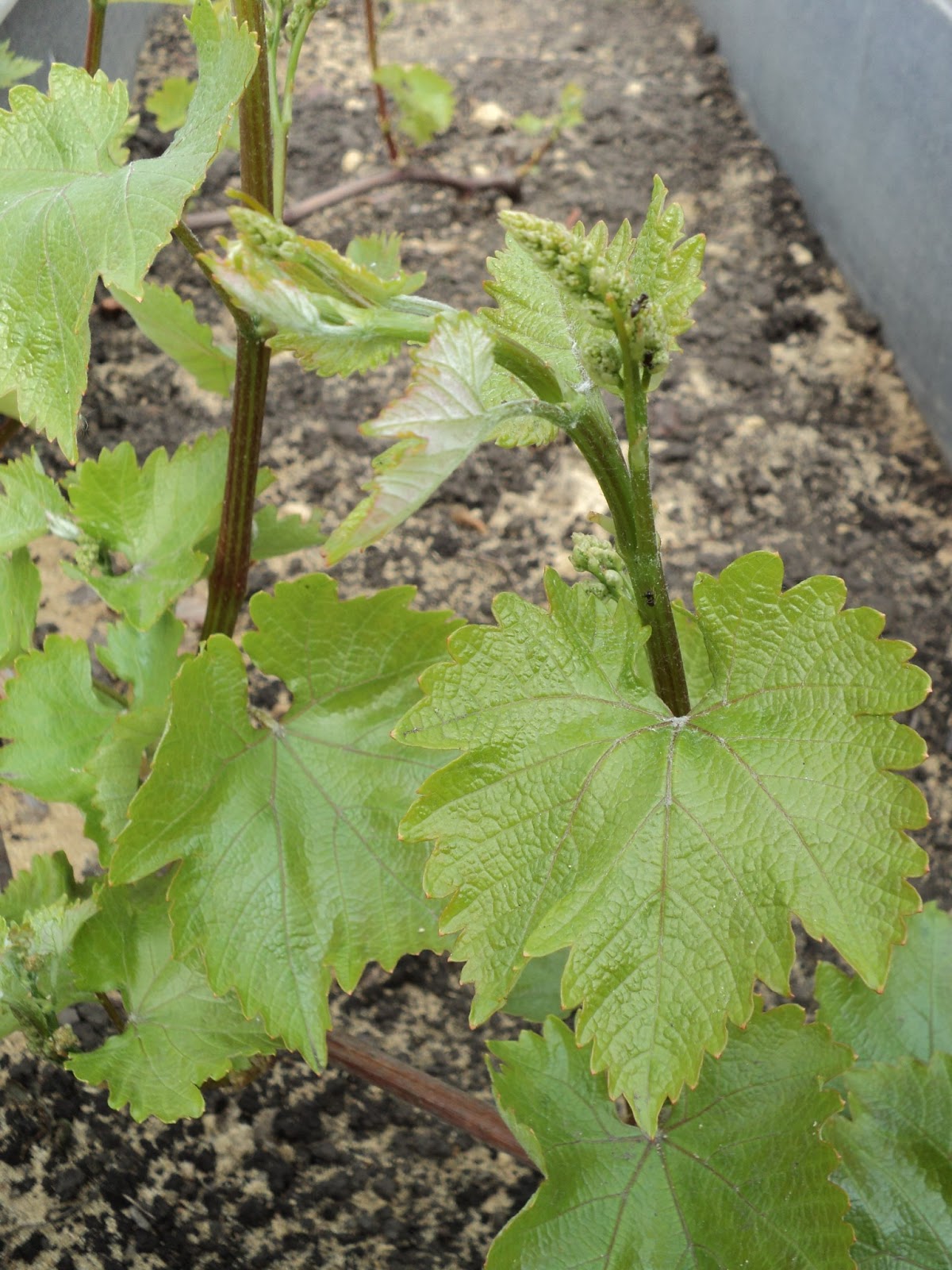
Grape varieties suitable for growing in Siberia
In order to get a great grape harvest in the harsh Siberian conditions, the issue of choosing a variety for planting should be a priority and most important. After all, not every variety is able to overwinter in Siberia and produce a harvest. In the very first attempts of gardeners to grow grapes in Siberia, the reason for the failures was the fact that they tried to adapt specifically southern varieties. Only later, thanks to the efforts of breeders, were special grape varieties developed for Siberia, which feel quite comfortable in such climatic conditions. Among them are:
- grape varieties of early and very early ripening in Siberia: Riddle, Thumbelina. Pinocchio, Siberian Cheryomushka, Muscat, Kaya;
- medium-ripening grape varieties in Siberia: Otgadka, Seyanets Sharova, Katyr, Savraska Bely;
- late ripening grape varieties in Siberia: Dubinushka, Biysk-2, Obskoy.
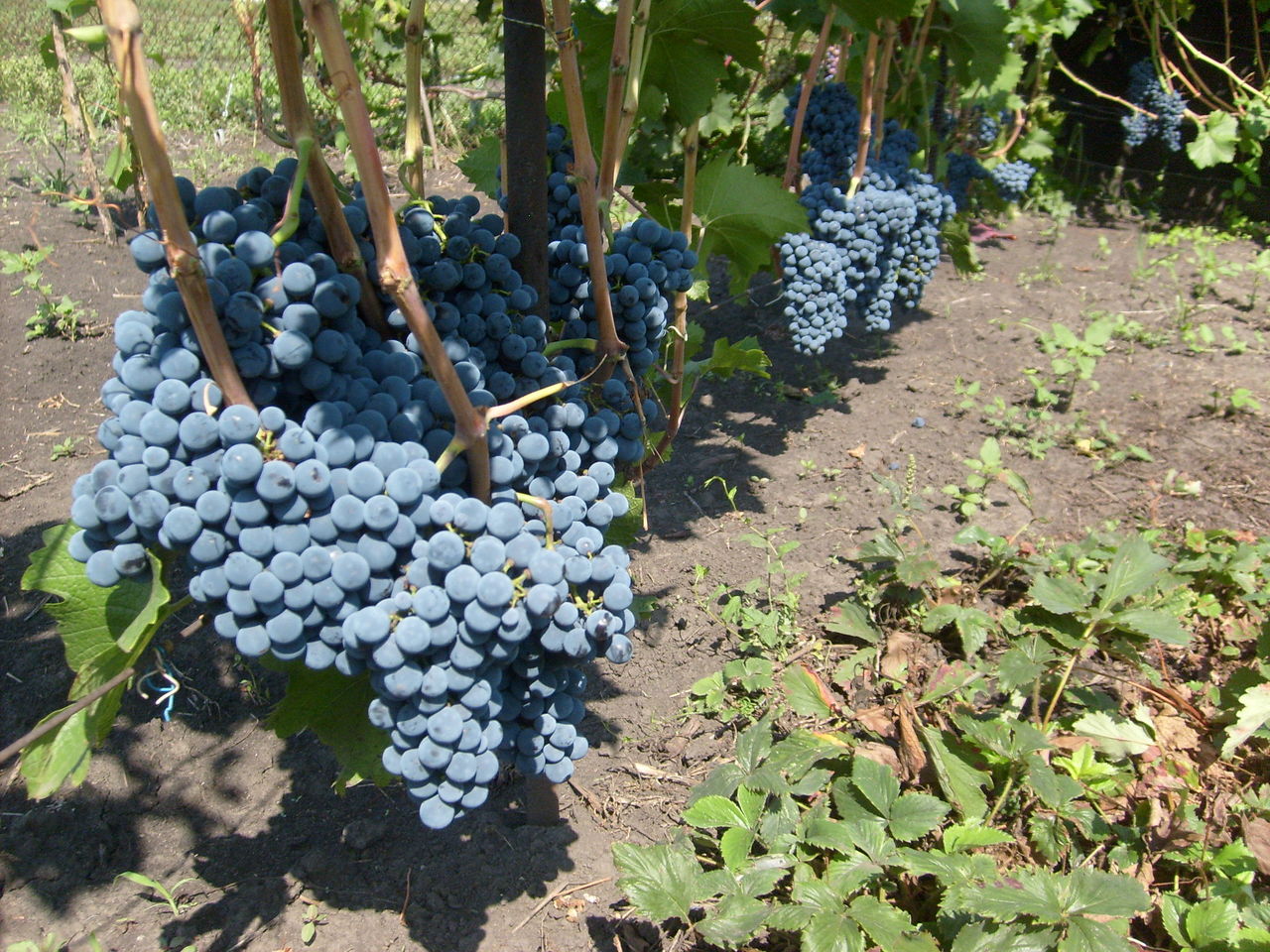
We grow grapes in Siberia
Step 1. Choosing a place for grapes in Siberia
Of course, if you want to plant grapes in your garden plot, then you are very limited in the choice of location. But perhaps you will be able to find and select on your site the most favorable area for grape growth. Follow these tips:
- when choosing a place for grapes, avoid lowlands where frosts will be felt most strongly;
- the southern and south-eastern side of the site is suitable;
- avoid northern slopes, windy places where snow cover can be blown away down to the ground;
- It is better to plant a grape row in the direction from north to south. So, in the first half of the day the bushes will be illuminated by the sun on one side, and in the second half - on the other;
- an ideal place for planting grapes may be a remote place near the fence on the south side of the site;
- Avoid wetlands and areas with high groundwater levels. Although, there are examples of successful grape growing in such areas;
- choose the driest, sunny, windless and highest area on your site. This will be the ideal place to plant grapes.
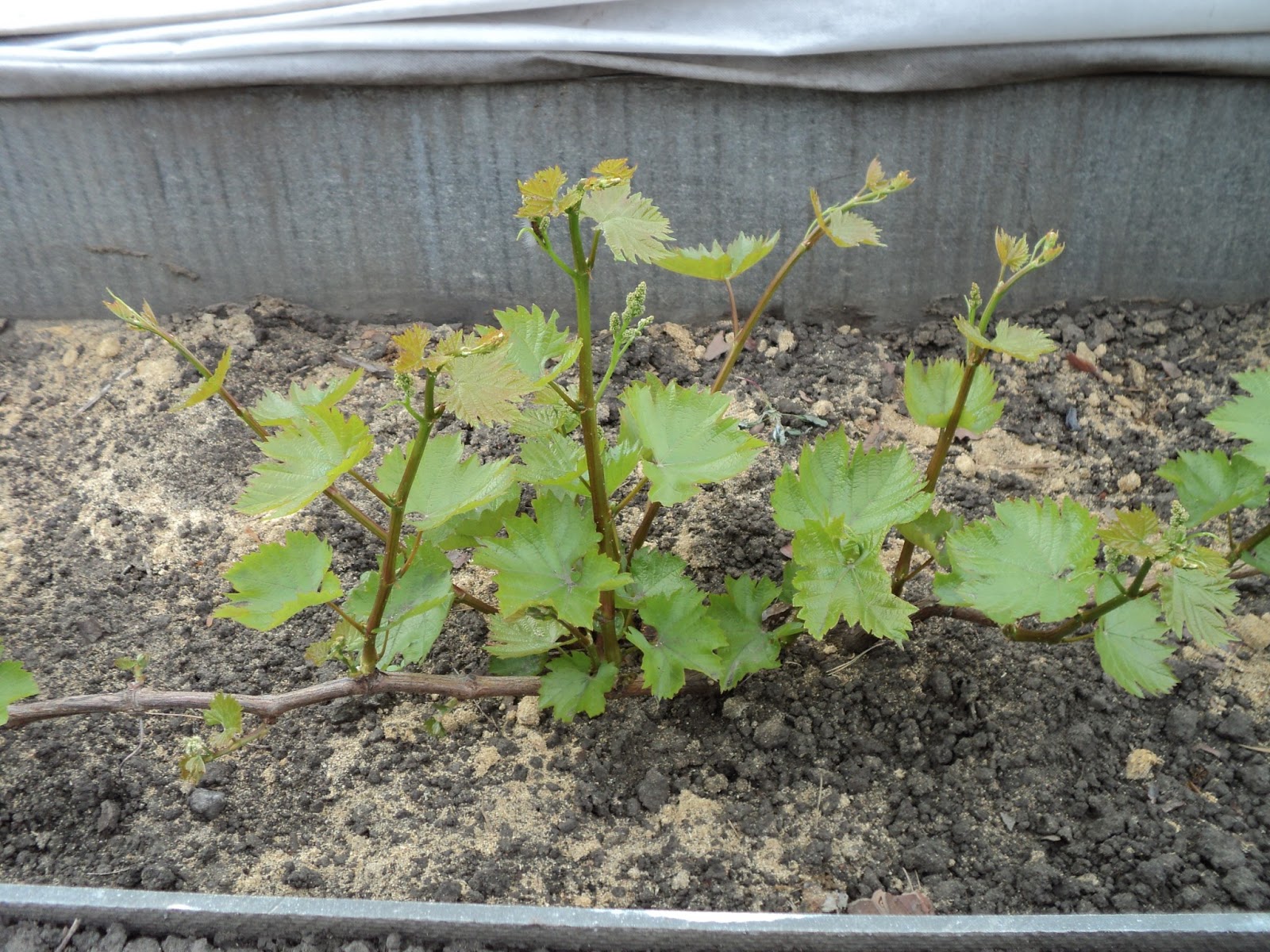
If you are going to grow a fairly extensive vineyard, then be sure to think about its layout. A lot will depend on this, including the quality of the harvest. To ensure good ventilation and good lighting for all rows, make row spacing from 2.5 to 3 m.
Step 2. Choose the time to plant grapes in Siberia
The timing of planting grapes in Siberia must be carefully chosen. It is no secret that in warmer climatic conditions, the formation of the root system of grapes can occur up to 8-10 times more intense. In Siberian conditions, you need to choose a time with at least 15 degrees of heat. Approximately grapes are planted in Siberia in the 2nd half of May. For planting, it is better to prefer a quiet evening or cloudy day. Do not plant grapes in bright sun - they do not like it.
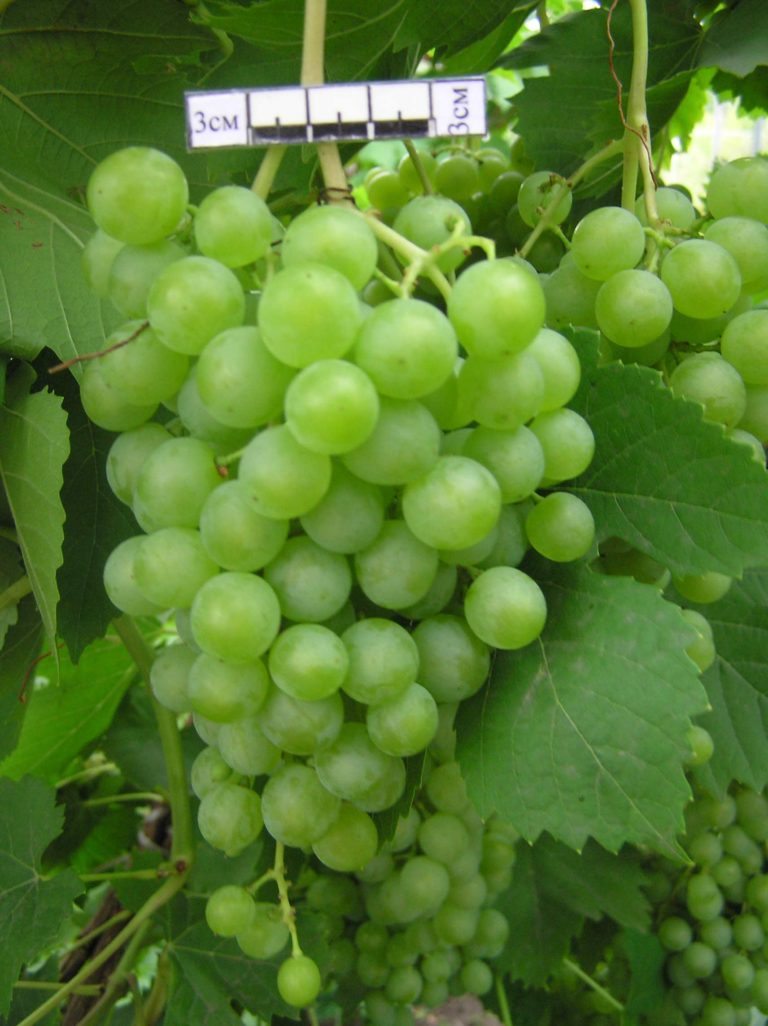
Step 3. Prepare grape seedlings in Siberia
To successfully grow grapes in Siberia, seedlings need to be properly prepared. For planting, you can choose vegetative seedlings that grew in plastic cups Houses. When planting, the earthen ball will not be disturbed, and therefore the fragile root system will not be disturbed. You can also choose seedlings that have overwintered in storage for 1 year. They need to be properly prepared for planting:
- shorten the roots to 10-12 cm;
- leave the strongest vines, if there are several of them, and cut them to 2 buds. If there is only one vine, then up to 3;
- then you need to soak the seedlings for one day in one of these solutions: a solution of heteroaunsin or sodium humate. The water for the solution should be 25-30 degrees;
- After soaking, the roots of the seedling are dipped into a clay mash and planting begins immediately.
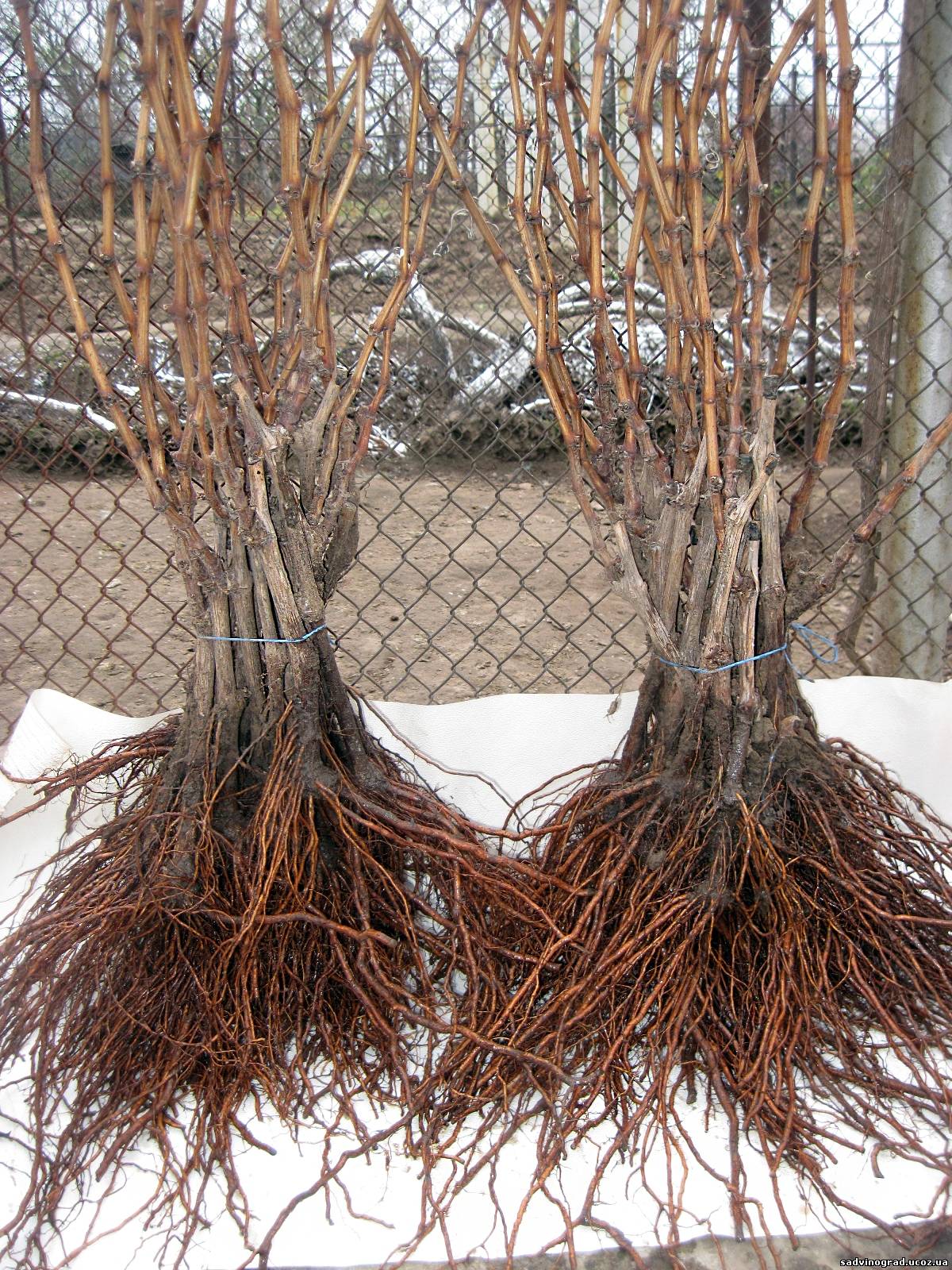
Step 4. Planting grapes in Siberia
Compliance the right technology when planting grapes is the key to successful cultivation. Siberian gardeners can be given the following instructions for planting grape seedlings:
- preparing the planting hole. Its depth must be at least 1 m, and its width must correspond to the size of the seedling;

- a drainage layer (for example, gravel) is poured onto the bottom of the dug hole, then compost or humus is laid;
- sometimes gardeners go to more energy-intensive efforts when planting. A piece of pipe is installed vertically into the planting hole for better access to air and water. The pipe should not rise too high above the ground, 20 cm will be enough. Otherwise, a lot of too cold air will flow through the pipe, which will contribute to freezing of the soil. Of course, the pipe cut should be covered with the plant in winter;
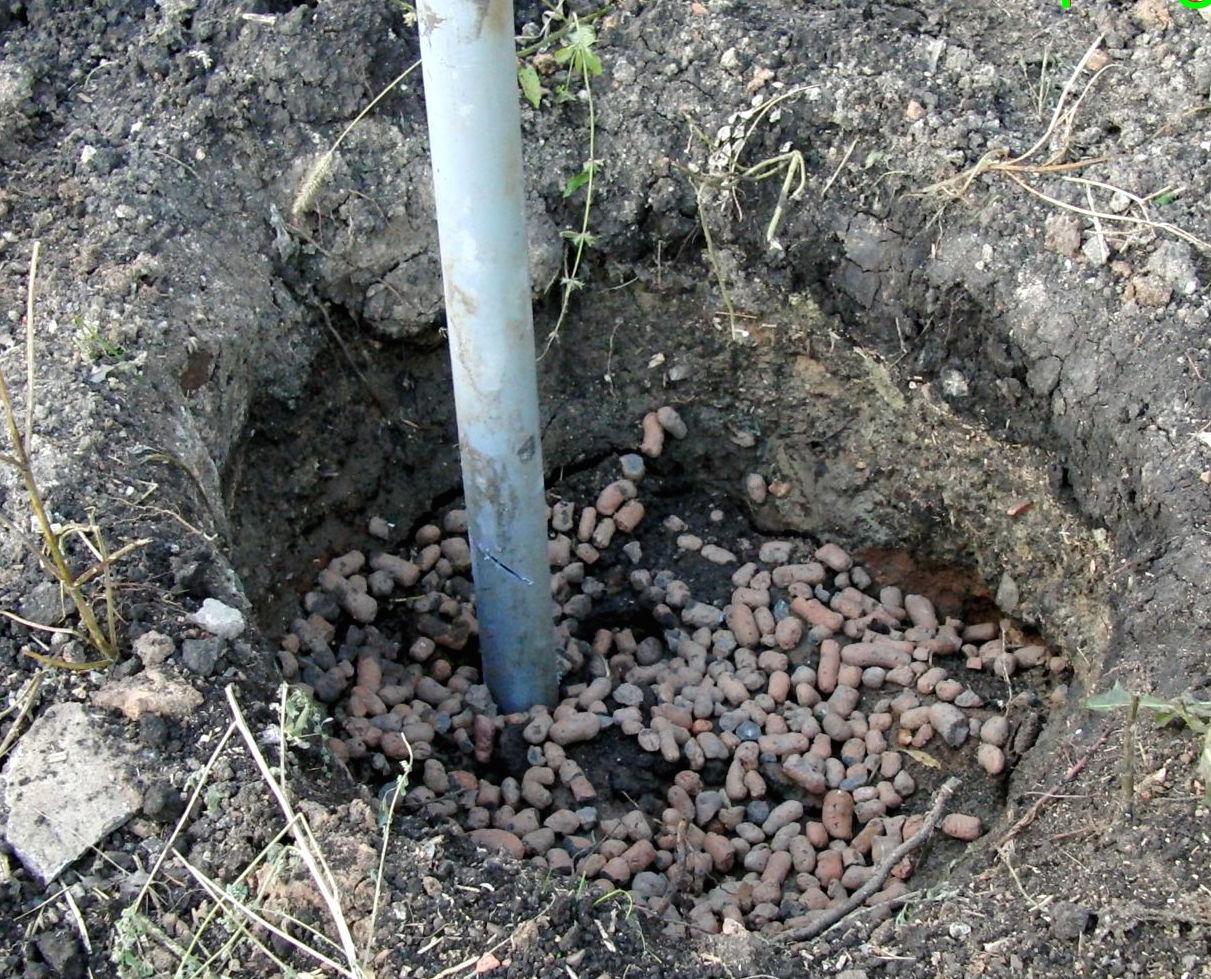
- the soil that was dug out of the hole must be mixed with sand and humus and poured back into the hole, leaving a mound. A seedling is placed on top of the mound, its roots are straightened and covered with earth;
- After planting, the young seedling requires mandatory watering.
Step 5. Caring for grapes in Siberia
Growing grapes in Siberia uses “harsh” technology, almost naturally. The young seedling does not require absolutely any feeding. The only important action to ensure full and proper growth is pruning. The task of the first year of growth of young grapes is to grow two powerful shoots:
- if the seedling initially had 2 vines when planted, then by the beginning of September they need to be pinched back to 1 bud. All emerging side shoots also need to be pinched to 1 stump;
- if the seedling initially had 1 vine when planted, then when it reaches 60 cm, you need to pinch the top to form lateral stepsons. Then you need to choose the strongest and most convenient for proper growth (in the opposite direction to the main vine), and pinch the rest onto a stump. You will definitely see how quickly this side shoot will catch up with the main branch in growth.
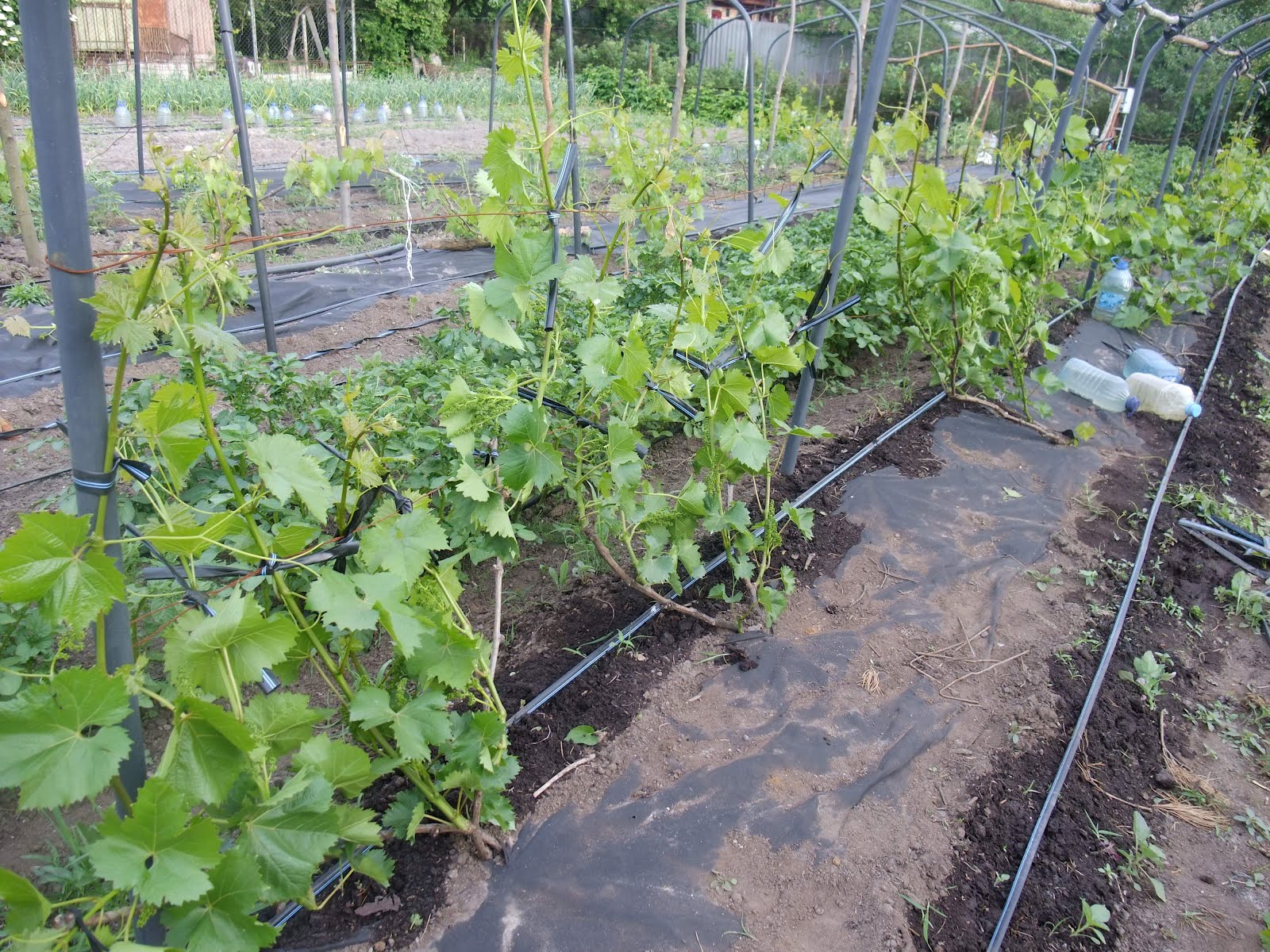
Pruning grapes in Siberia
For grapes in Siberia, pruning is very great importance. Of course, this procedure differs from the “southern technology” due to the fact that autumn in Siberia is very short. Pruning is carried out not in 1, but in 2 stages:
- Trimming stage No. 1. Time: end of August - beginning of September. The grape harvest has already been harvested, and it is time to carry out the first pruning of the vineyard. All dry shoots are removed. damaged, weak, the vine that has already bear fruit is removed.
- Trimming stage No. 2. Time: before sheltering for the winter. The later you prune the bush for the winter, the better. It is not recommended to postpone the 2nd pruning until spring, because in the spring, due to the abundant sap flow, the beginning of the appearance and opening of buds, by pruning you can delay the ripening period by more than half a month, which is extremely undesirable for the short summer in Siberia. The technique for pruning grapes is no different from pruning in other climatic conditions. The main task is to create a replacement process, or “fruit link”. Of the two strong shoots that grow side by side, one is cut short, and the other is left long, with sufficient quantity buds - from 10 to 20. In summer, one of the shoots will produce a harvest, and the other will produce powerful green shoots. In autumn, the pruning process for such branches is carried out in reverse: the one that was left long is cut right to the stump, and the second one is left long. This method of pruning allows you to avoid thickening the bush and rejuvenate it.

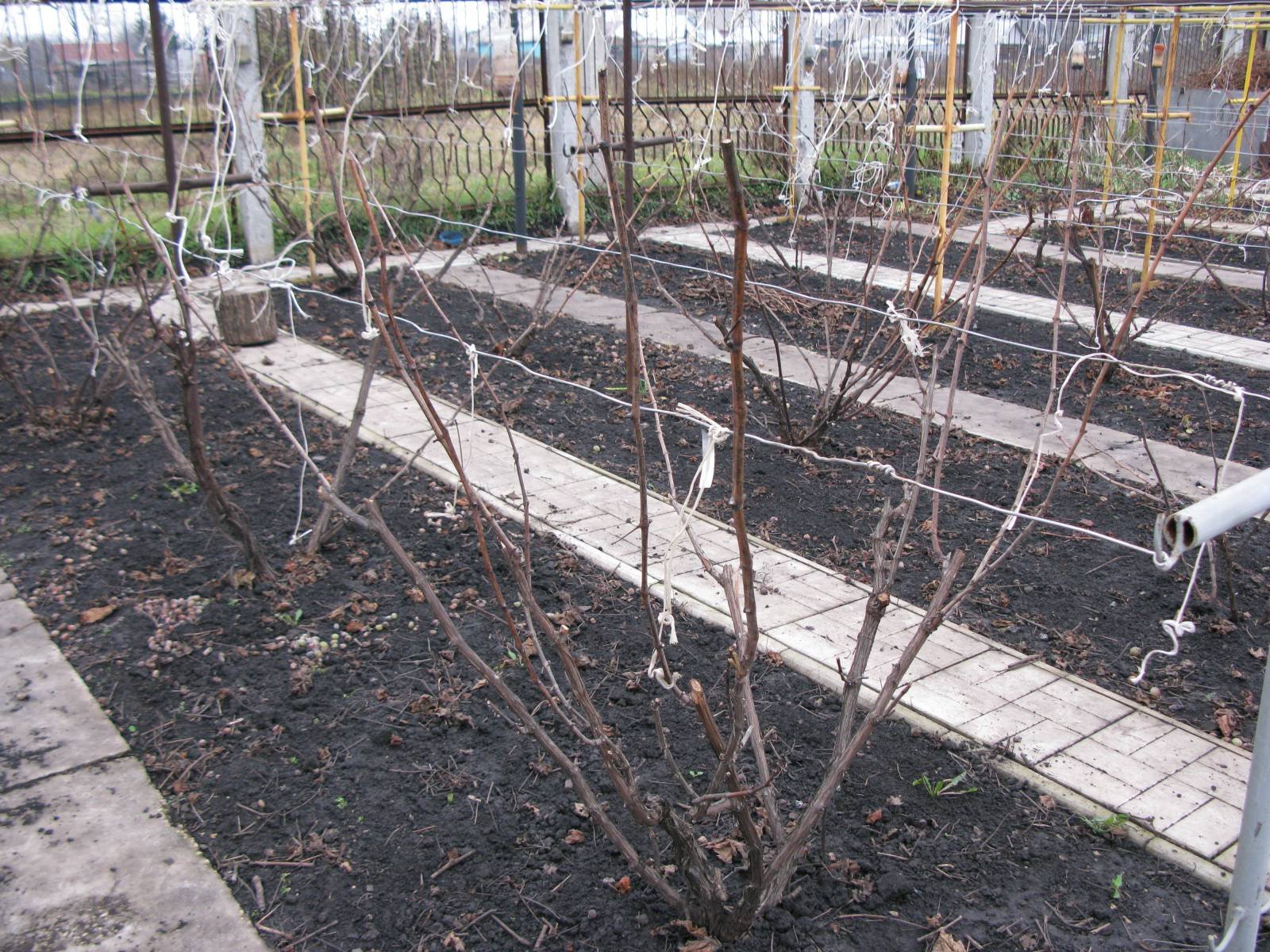
Load of a grape bush in Siberian agricultural technology
Correct loading of the grape bush is very important for Siberian agricultural technology. It is calculated by the number of eyes on a branch - future buds from which inflorescences and clusters will appear. If you load the bush too much, the quality of the berries will deteriorate, the bunches will ripen slowly, and the plant will not have enough strength for new shoots that should appear over the summer. If there is insufficient load on the branches, the plant will use absolutely all its strength to grow huge branches. The plant will go into hibernation weakened, the roots may freeze. Therefore, when creating the correct load for grapes, Siberian gardeners must adhere to the following principles:
- During the first 2 years, the plant increases the power of the root system, grows freely and gains strength.
- For the first fruit-bearing summer, you need to leave no more than 20 eyes - future clusters.
- For the second fruit-bearing summer, the load can be increased to 40 eyes per bush.
- In the 3rd year we increase the load 1.5 times - 40-60 eyes.
- In the 4th year we increase the load to 80 eyes per bush.
- A full-fledged adult plant can then be loaded with from 80 to 150 buds, depending on the vigor of growth and the variety.
- If the variety is small-berry, then a slightly larger number of eyes is allowed, but within normal limits. The large-berry variety can be loaded a little less, but also within normal limits.
- If we talk about whether to prefer damage from overloading or underloading a bush, then it is better to choose underloading. Although, you need to strive for the ideal number of bunches in accordance with the age of the grapes and their growth rate.

Hardening of grapes when grown in Siberia
One of the main features of the Siberian grape growing technique is its hardening. Experienced gardeners do not recommend creating greenhouse shelters for plants. The only exception may be a situation when unexpected severe spring frosts can “beat” young plants that have not yet been raised to the trellis. Only in such cases can the grapes be covered with film for a while. Hardening of grapes in Siberia is aimed at:
- acclimatization of the plant;
- the emergence of resistance to daily temperature fluctuations;
- the emergence of resistance to seasonal temperature fluctuations;
- successful wintering of the plant.
If you constantly keep the grapes in shelter, you will only pamper the bush. Of course, it will successfully withstand all seasonal temperature fluctuations and even produce a good harvest, but such a bush simply will not survive the Siberian winter.
Covering grapes in Siberia before the onset of winter
The Siberian winter is famous for its severity. Air temperatures can drop below 50 degrees. Therefore, covering the vineyard is one of the primary tasks in the successful cultivation of this crop. Gardeners begin to prepare their vineyards for winter, when the average daily temperature reaches 0 degrees. This usually happens in mid-October - early November. At this time, the sun is no longer able to warm the soil, which will prevent rotting and rotting of the grapes under cover. To avoid possible mistakes for grapes in winter in Siberia, consider the following tips:
- The grapes should already be pruned by the time wintering is organized. The vines are removed from the trellises and laid along the trenches;
- It is very important that the bush is completely dry. The slightest moisture getting under the cover can cause infection with fungal diseases. It is better to cover the grapes on a sunny, windy day;
- The vines are covered with film or durable cloth and buried in soil. The top is thickly covered with spruce branches;
- when snow cover is established, monitor its presence in the sheltered vineyard;
- the top layer of the shelter is removed after the snow melts;
- The film is removed around April, when active sap flow processes begin. They switch to another, lighter shelter - a film greenhouse on arcs. Insulation will no longer be necessary when the threat of night and other frosts has finally passed.
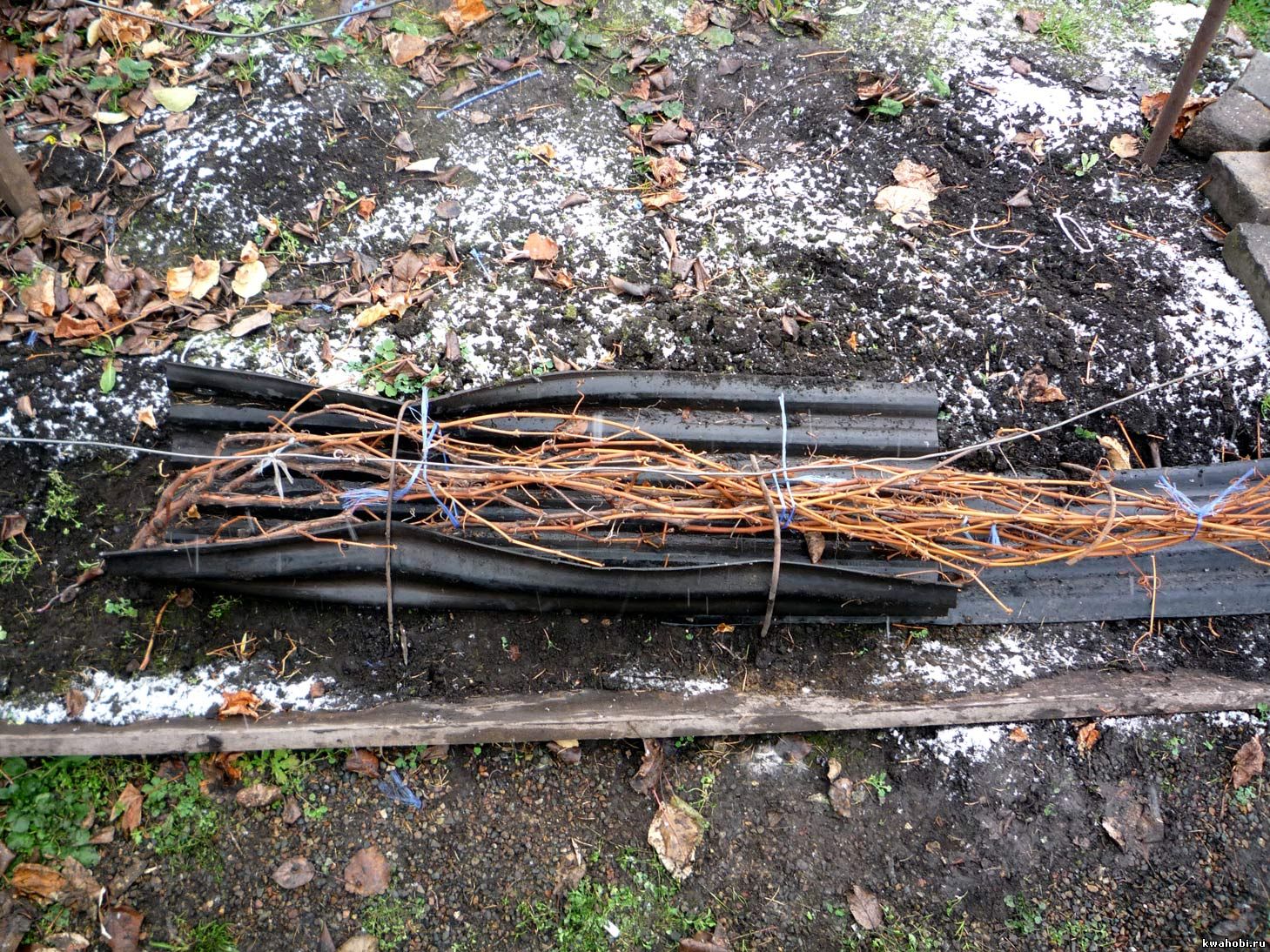
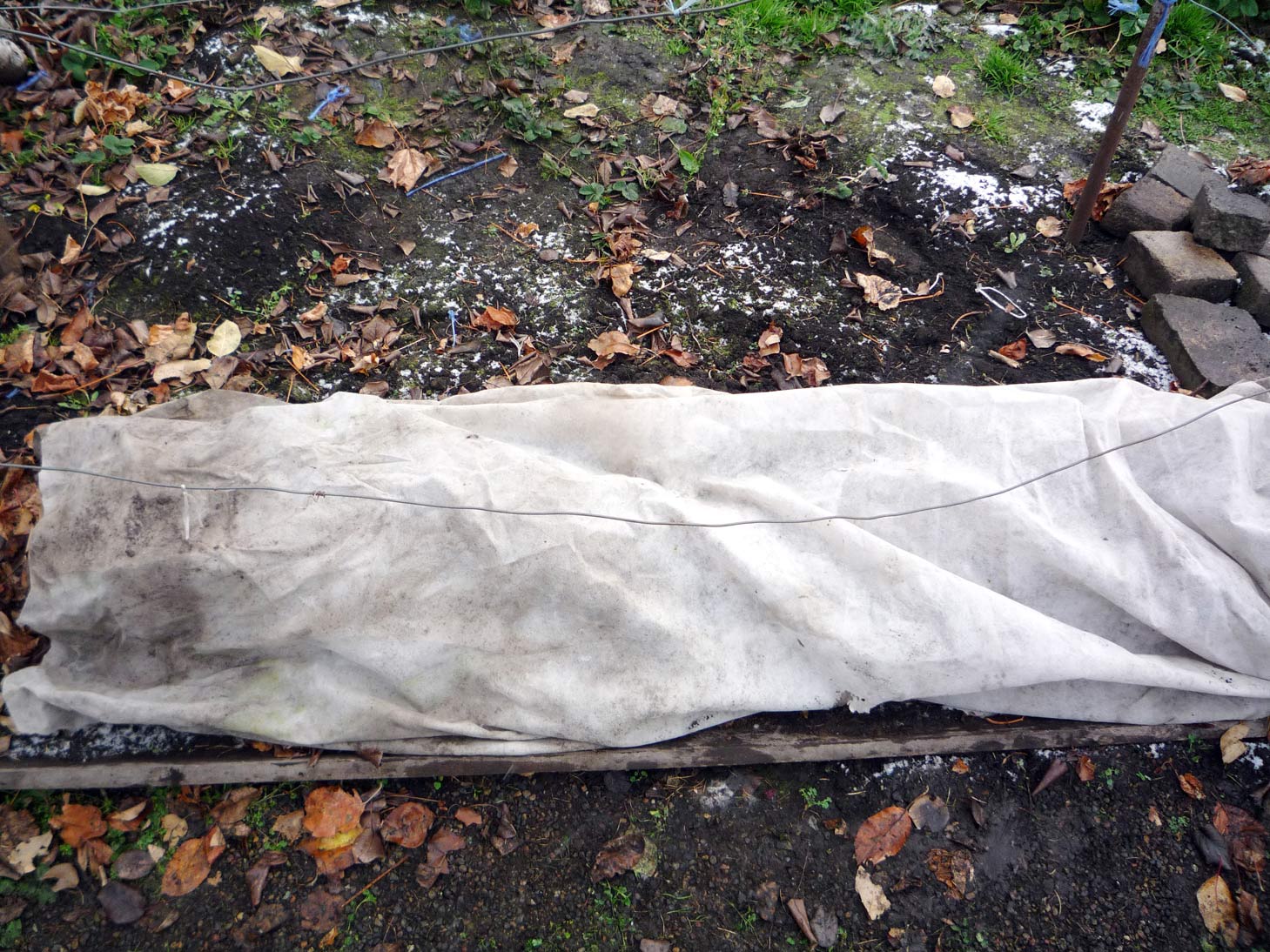
Finally
As you can see, there is no need to be afraid of growing grapes in Siberia. The many years of experience of gardeners in these parts has reached such a level that it is quite possible to harvest harvests similar to the “southern” ones. It is worth adhering as strictly as possible to the following principles of growing a vineyard in the climatic conditions of Siberia:
- for cultivation, it is advisable to select special varieties of Siberian selection;
- Grapes in Siberian conditions require fairly severe hardening to develop good resistance to low temperatures and sudden changes. Grapes require shelter only for the winter and for a while possible frosts in spring;
- try to strictly observe the load for the bush: no more than 20 eyes in the first year of fruiting. Gradually increase the load every year;
- short autumn in Siberia requires pruning in 2 stages: after harvesting and before wintering;
- Make sure there is sufficient snow cover in the sheltered vineyard.
For novice gardeners it can be quite useful information about growing grapes in Siberia in the video.
A rich harvest of the most delicious grapes!
Grapes, traditionally considered a southern crop, have long been successfully grown in Siberia. This opportunity arose not because the harsh Siberian climate softened, but thanks to breeders who developed frost-resistant varieties. However, in short summer conditions, even unpretentious grapes need special care.
Opportunity to grow large and sweet grapes in Siberia - a good gift for gardeners in this region. Varieties have been developed that are adapted to a sharply continental climate with strong fluctuations in both daily and annual temperatures. The warm period without frost here lasts three months: from early June to early September. Therefore, early varieties grow well in Siberia: Muromets, Solovyova-58, Tukay, Rusven, Kodryanka and other early ripening varieties, in which 90–115 days pass from bud break to full ripeness of the berries.
Photo gallery: grape varieties suitable for growing in Siberia
The Rusven grape attracts wasps with its large sweet berries and needs protection with a net. Large Kodryanka berries are collected in clusters weighing 400–600 g, but some reach 1.5 kg. The Solovyova-58 grape variety is well suited for winemaking. Muromets is a grape for raisins, the pulp is fleshy, no aroma, brush weight - up to 400 g Tukai grapes are distinguished by a strongly growing bush and large clusters
Planting grapes in Siberia
Proper planting of grape bushes is one of the important factors influencing a good harvest.
Selecting a location
Choose a place that is sunny and protected from the wind. Grapes should not be planted in lowlands, where frosts, fogs and stagnant water are more common. On a personal plot, it is better to place grapes near a blind fence or wall of a house facing south or southeast.
In one place, grapes can grow and produce good yields for 15–20 years.
Video: choosing a place for grapes
Deadlines
The most favorable time for any planting in Siberia is spring. Autumn here is very short, snow can fall as early as September, and seedlings simply will not have time to take root during autumn planting. Plant grapes in May under cover (in a greenhouse, greenhouse) or in open ground when the threat of frost has passed. In some regions of Siberia there are snowfalls even in early June.
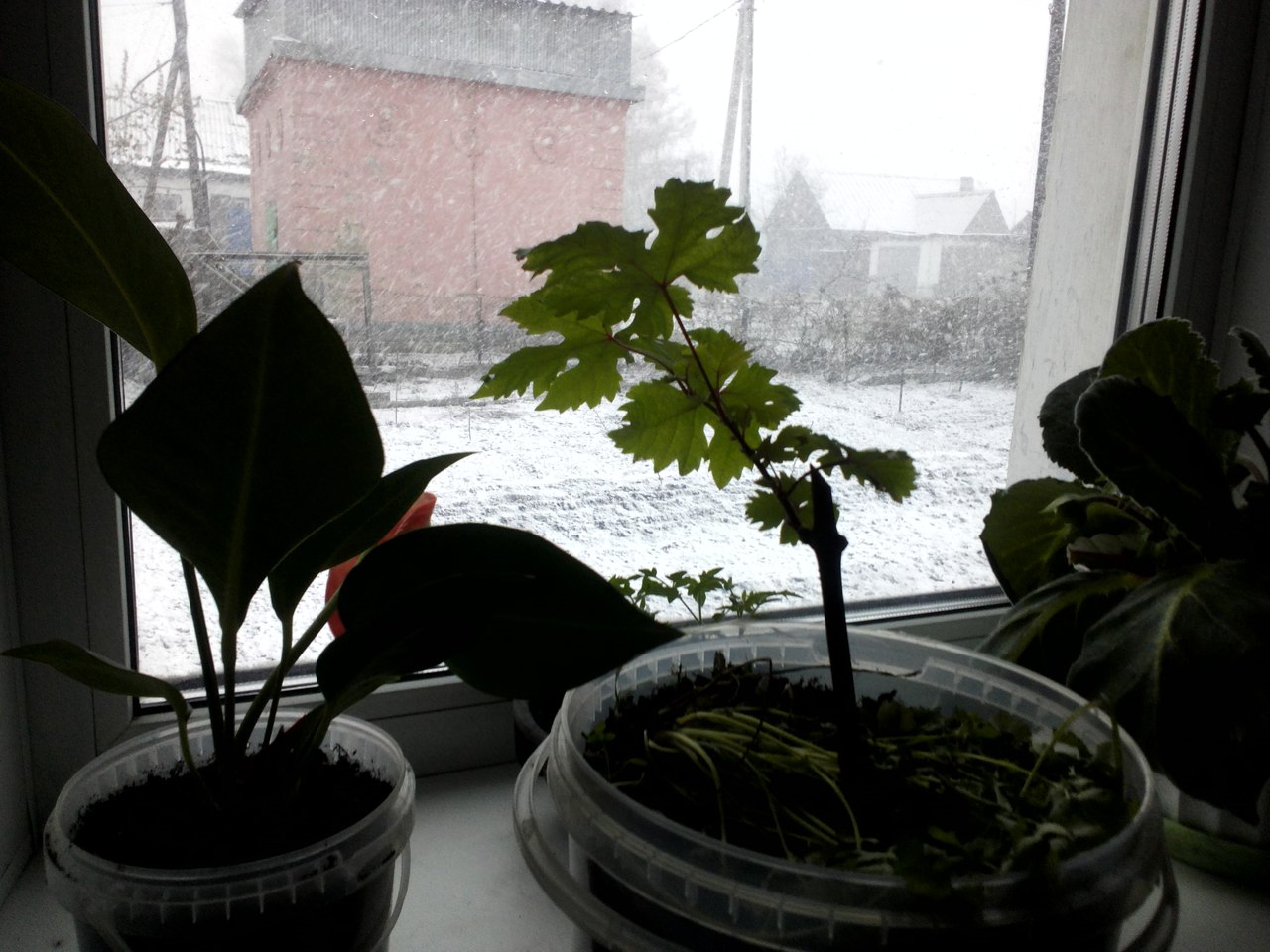
In Siberia, there is a high probability of frosts and snowfalls until June, so seedlings purchased in the spring must be kept on the windowsill until the weather warms up.
Pit preparation
During the growing season, grape shoots grow by 5–10 cm per day. Such active growth requires good nutrition. If grapes are planted in unprepared soil, then all the nutrients from the top fertile layer are quickly consumed. The bushes will develop and bear fruit poorly. Therefore, at least 2-3 weeks before planting the seedlings in a permanent place, planting holes are prepared for them and filled with fertilizers.
Preparation of planting holes:
- Dig a trench 30 cm deep and 80 cm wide; towards the bottom it can narrow to 60 cm. The length depends on the number of seedlings. The distance between the bushes should be 2 m. If you plan to plant in 2 rows, then the row spacing is 2–3 m.
- Place the top layer of soil (on the bayonet of the shovel) in one direction, and everything below in the other.
- Under each seedling inside the trench, dig a planting hole 60 cm deep and wide, that is, the total depth at the planting sites should reach 90 cm from ground level.
- Place a shovelful of ash and 200 g of superphosphate at the bottom of the planting holes. Lay down a layer of twigs and rough weed stems.
- Fill the holes with a mixture of humus, top layer soil and river sand (1:1:0.5).
- There is no need to fill the trench itself; reinforce its walls with boards. Thus, the grape bed will be recessed into the ground, that is, there should be 30 cm from the planting level to the ground level (trench depth).
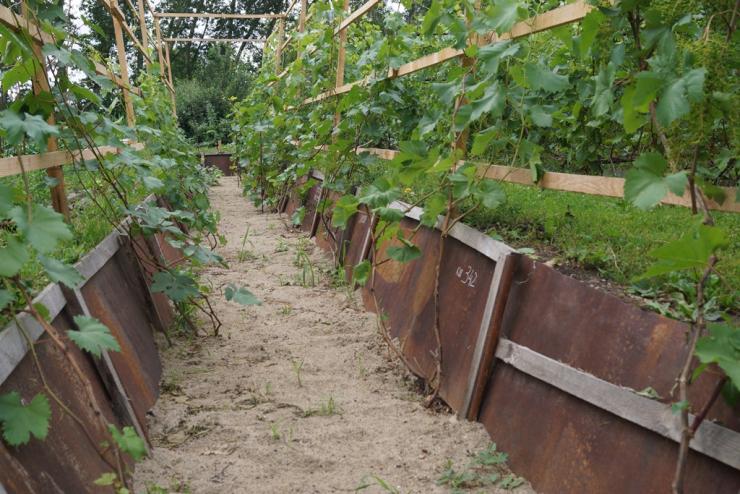
The grapes are planted below the soil level on the site, the walls of the trench are reinforced with shields
For Siberia, with a planting depth of 20–40 cm, the heat received during the summer is used as fully as possible. The trench can be made wider, then it will be better illuminated by the sun. The planting pit is also often made larger. It is believed that a 1 m deep pit, filled with organic matter and mineral fertilizers, will provide the grape bush with nutrition for 10–15 years, that is, fertilizing will not be needed throughout the entire cultivation.
If you want to do without fertilizing and not dig a huge hole, sow the soil under the bushes and between the rows with green manure: alfalfa, mustard, clover, peas, lupine, wheat, oats. These plants contribute to the redistribution of nutrients between soil layers and the accumulation of humus. Grow green manure until flowering, then cut it and place it under the grapes as mulch.
Drainage system
There are recommendations to lay drainage made of stones and broken bricks at the bottom of the planting hole and install a pipe through which the grapes are watered. But there are also reviews from gardeners who did not see the difference between planting grapes in “smart” pits and in ordinary ones. When watering through a pipe, the roots are drawn towards it, rather than developing evenly in depth and breadth. Over the years, drainage becomes silted and the roots can rot.
![]()
The “smart” pit in Siberia does not justify the effort required for its construction
Many winegrowers agree that “smart” pits are needed only in the first 1–2 years after planting, and later they lose effectiveness as the roots extend beyond its boundaries. However, in the climatic conditions of Siberia, it is not practical to make drainage systems, since young non-fruit-bearing bushes rarely need watering - 2-3 times per season.
There are few hot days in the region; the weather is often rainy. In addition, the evaporation of leaves from young grapes is minimal; they have not yet developed into a strong bush. The best option- instead of stones, place branches at the bottom of the hole, which will rot over time and turn into fertilizer, and after planting, cover the soil with a layer of straw, hay, grass cuttings or green manure.
Seedling preparation and planting
Grape seedlings in Siberia are rooted cuttings with a closed root system. They are sold in plastic cups. Many people buy them in early spring, while there is a choice and prices are low, so preparation for planting and planting itself consists of the following stages:
- If you bought seedlings at the beginning of spring, then transplant them from cups into larger pots and keep them on a windowsill, glassed-in balcony or in a greenhouse until the end of frost. Use soil for replanting from your site, mixing it with humus (1:1).
- IN warm days(20⁰C and above) take the cuttings out into the open sky, first for an hour, gradually stay under sun rays increase until daylight, be sure to put it in a warm place at night.
- After June 5–7, you can start planting in open ground; the day before, water the seedlings well.
- For each seedling, dig a hole the size of the pot in which the grapes grow in a previously prepared planting hole.
- Take out the seedling along with a lump of earth and place it in the hole at an angle in the direction in which you will bend and lay the vine in the fall for shelter for the winter. Bury the seedling to the first green petioles.
- Cover with soil removed when digging the hole, pour a bucket of water and mulch.
Video: how to properly plant grapes in Siberia
Caring for grapes in Siberia
Growing grapes is a complex of agricultural practices, which includes: watering, shaping and thinning, tying to trellises, providing heat, shelter for the winter. Diseases and pests of grapes have not yet reached Siberia, so there is no need to spray the plantings with anything.
Watering
This sunny crop is resistant to drought and heat. The soil under the grapes should be dry. Water requirement is determined by appearance plants - leaves lose their elasticity in the heat and droop. To water the seedling, make a groove 15–20 cm deep around the circumference, 30 cm away from the stem, pour 5–15 liters of water into it. The rate depends on how well the soil absorbs. Use only water heated by the sun. After watering, level the ditch and mulch.

To water the grapes, dig furrows or holes
In the Siberian summer, seedlings will rarely need to be watered after planting, especially if the vineyard is located in a place protected from the wind and the ground is covered with mulch. A fruiting vine needs more water. But the frequency and rate of watering depends on the weather. The signal is still the condition of the grapes. Pay special attention to it during the periods:
- immediately after bud break;
- 2 weeks before flowering;
- 1–2 weeks after flowering;
- before winter shelter.
If the weather is dry during these important stages of development, be sure to water the grapes, soaking the top 30–50 cm. Do not water during flowering! In August, watering is also undesirable; the vine will ripen better without it.
About the importance of mulch
Mulch keeps the soil moist and loose, the bottom layer gradually rots, and the top remains dry and does not allow fungi to develop. Thanks to mulch, there are no sudden temperature changes in the root zone during rain; in hot weather, the covered soil remains comfortably cool. In addition, such litter, when rotting, releases carbon dioxide - one of the elements of photosynthesis.
Apply mulch in the spring only after the ground has warmed up. Rotted sawdust, grass cuttings, hay or straw are suitable. These natural materials By autumn they will rot and enrich the soil with humus.
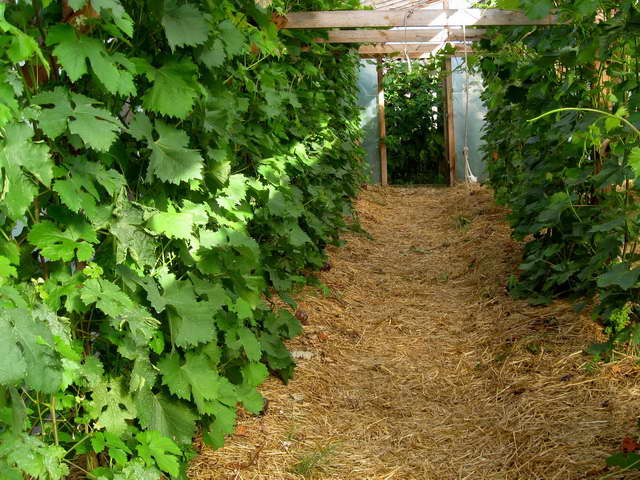
Mulch keeps the soil moist and loose, the bottom layer gradually rots, and the top remains dry and does not allow fungi to develop
Bush formation
In the first year, start with a garter; it is not necessary to build a trellis, just stick stakes or reinforcement 1.5 m high next to the seedlings. Leave the two strongest shoots on each cutting; when they grow to 50–60 cm, tie each to its own support in the shape of the letter V. It happens that only one shoot grows on a cutting, tie it up too.
All summer long, stepsons will grow from the axils of the leaves; they need to be pinched. Some winegrowers recommend pinching the stepsons not at the base, but above the second leaf. In their opinion, additional leaves improve photosynthesis, and the young vine receives more nutrition and strength. In August, do the chasing, that is, pinch the tops of the main shoots.
Stages of forming a bush from a seedling with two shoots (the simplest scheme):
- In autumn, after the leaves fall off, cut one shoot into 4 buds, and the other into 2. The first will become a fruit shoot, the second - a replacement shoot, and together they form a fruit link.
- In the spring of the second year, tie the arrow and replacement shoot to the trellis horizontally, and direct the stepsons growing from the axils of the leaves vertically.
- In the fall of the second year, cut the long sleeve of 4 buds in half, that is, both sleeves will now have two vertical shoots. Then shorten these four shoots: those closer to the center of the bush by 2 buds (replacement shoots), and those further away by 4 (fruit shoots).
- In the spring of the third year, tie the fruit shoots horizontally, and allow the replacement branches to grow vertically. Over the summer, 12 stepsons will grow - tie them up vertically.
- In the autumn of the third year, cut each of the two horizontal branches (fruit shoots) to a replacement knot along with the outer four shoots. Once again, only four vertical shoots will remain in the bush. We cut them again according to the same principle: those closest to the center of the bush into 2 buds, the remaining two into 4 buds.
- From the spring of the fourth year, continue formation according to the given scheme.
Photo gallery: pruning grapes by year
First year: in the fall one shoot is cut into 4 buds, the second into 2. Second year: in the spring the shoots are tied horizontally, vertical stepsons grow from the axils. In the fall, the arrow is shortened by half, replacement knots (2 buds) and arrows (4 buds) are formed from the remaining shoots. Third year: in the spring, the arrows are tied horizontally, replacement knots - vertically. In the fall, both arrows are cut off to the replacement knots; from the remaining shoots, arrows (4 buds) and replacement knots (2 buds) are again formed.
If only one shoot grew on your seedling in the first year, then in the fall cut it into two buds, from which by next year you will form an arrow and a replacement shoot, then follow the given scheme. In Siberian conditions, you can leave shoots with big amount buds (5–6), that is, do not shorten the vine too much in case of freezing in winter. But in the spring, do not trim the main branches, but blind the extra buds and shoots. If you leave them, they will take away strength, thicken the bush, and the grapes may not have time to ripen in a short summer.
Clusters will be formed on vertical shoots already in June; leave only the lower, well-developed ones, and pluck out the upper ones. If you leave everything, then in a short summer they will not have time to ripen.
Having understood the principle of formation, experiment, leaving different quantities buds, shoots, inflorescences. This way you will find out from your own experience under what conditions you can get the maximum yield.
How to provide additional heat to grapes in Siberia (arrangement of trellises)
Trellis can be not only a support, but also protection for grapes. Classic trellises consist of metal or wooden posts with wire stretched between them.
Design features of trellises that allow heat accumulation:
- A canopy over the trellis: at night, the cold air coming from above is cut off and the heat rising from the ground is retained.
- The ends are covered with film - protection from the wind.
- Reflective screens made of foil or aluminum sheets around the perimeter of the trellis - the effect of better illumination and also an additional source of heat.
Video: single-plane trellis for grapes
Sheltering grapes for the winter
After harvesting (and young seedlings in late August - early September), the grapes need to be protected from the first frosts. To do this, cover the ground under the bushes with old film, remove the vines from the supports, lay them on the film, and build a greenhouse on top in the form of a tunnel made of polycarbonate or arcs and film. As a result, when the temperature drops at night, the leaves will not freeze, and during the “Indian summer”, when there are still warm days, photosynthesis and bud ripening will continue.
After leaf fall, with the onset of cold weather, remove the temporary shelter and leave the film on the ground. Build something like a box with sides on top. It is necessary to make such a structure so that the grapes are in the air gap, and not sandwiched between the upper and lower shelters. Place cardboard, foam sheets, agrofibre, burlap or other insulation on the sides of the box. Cover the whole thing with film on top and tuck the edges in place. Water should not get inside the shelter, otherwise the grapes will dry out. For waterproofing, you can use slate, roofing felt and other materials.
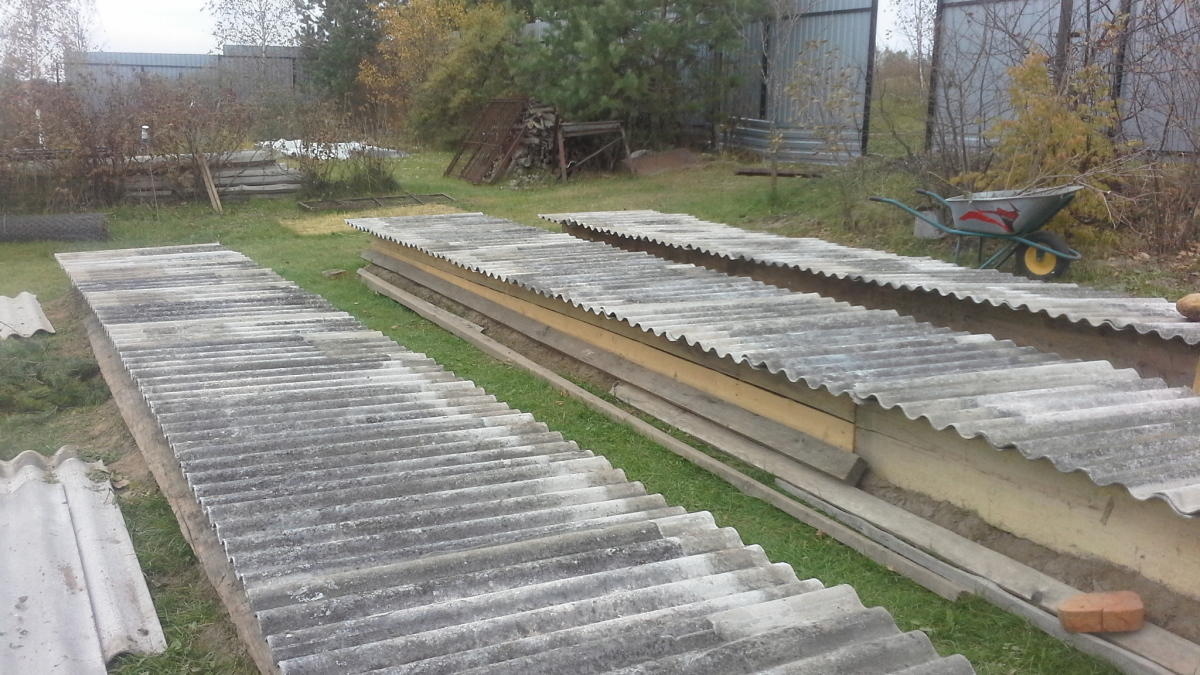
The grapes are placed in boxes, insulated and protected from getting wet by slate
In winter shelter, grapes should not come into contact with metal (arches, pins). Otherwise, the shoots in this place will freeze and the buds will die.
In the spring, when the snow melts, remove the cover. In Siberia, this can happen in April and May. There is no need to wait for the soil to thaw. Don’t raise the vines, but build a greenhouse, just like in the fall. You can remove it and tie the shoots to the trellises only when the threat of frost has passed, that is, in June. On warm days, do not forget to open the ends and ventilate.
Many gardeners living in northern regions In Russia, they do not grow grapes, believing that this garden plant is a heat-loving plant and should be grown exclusively on the territory warm countries. This opinion is fundamentally wrong. And if several decades ago it was almost impossible to find a grapevine in Siberia, today Siberian gardeners are happy to grow rich harvests.
Siberia is excellent for growing grape bushes. This is due to the climatic characteristics of this region, due to which many grape diseases characteristic of southern regions, and grape pests have a minimal level of activity.
Where to start planting grapes for beginners? Of course, with the choice of a suitable grape variety. When planting garden plants in Siberian conditions, maximum attention must be paid to the choice of varieties.
Choosing a grape variety for growing in Siberia
For cultivation in Siberian regions, it is recommended to choose grape varieties with increased frost resistance. It is useless to plant southern varieties of garden plants in such an area - they will simply freeze. It is necessary to choose breeding varieties that are specially adapted for cultivation in harsh climates - short summers and long, snowy winters.
Among grape varieties, which are ideally suited to Siberian weather conditions and withstand even the most low temperatures, relate:
- Siberian cherry.
- Thumbelina.
- Srostinsky.
- , Muscat.
Also, such breeding varieties of grapes as Solovyova 58 and White Miracle are perfect for Siberia.
How to choose a location for a vineyard?
After the winegrower has decided on the varieties of garden plants, it is necessary to choose the right location for the future vineyard. Grape bushes should be grown in a bright, dry area, preferably protected from winds from the north and north-east. Great option It will be located along the walls of buildings or high fences, which will reliably protect the plant from the wind.
The attention of novice gardeners should be drawn to the fact that the roots of the grape bush grow very strongly, and therefore it is imperative to maintain the necessary distance between the bushes and rows. It is recommended to leave a distance of at least 2 m between rows, and 2.5 m between individual bushes.
Planting grapes
Planting grape bushes in Siberia is done in two ways - planting trenches or planting holes. You need to dig a trench 60-80 cm deep and 50 cm wide. The length of the trench depends on how many bushes the winegrower plans to plant. Instead of a trench, you can dig planting holes - about 50 cm in diameter and 60-70 cm in depth. 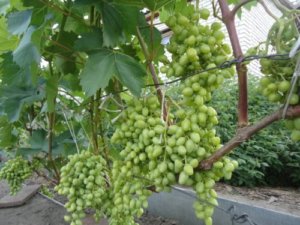
Next, the bottom of the dug hole or trench is filled with gravel, expanded clay, and broken bricks, after which a layer of fertile soil mixed with the same amount of compost or humus is poured. After this, 500 mg of superphosphate and 20 mg of potassium are added to each hole, then all layers are repeated until the hole or trench is almost completely filled.
Next, they move on to the actual planting of the seedling. The roots of the seedling must be carefully straightened, slightly deepening them into the soil. The holes do not need to be completely filled - there should be approximately 10-12 cm left to the edge of the hole. Next, the hole needs to be filled with soil and watered generously with at least 2 buckets of water. In the first days after planting, it is recommended to water the seedlings every 3 days.
Caring for young seedlings
After spring planting, grape seedlings must be watered - in this case, watering should be rare, but quite plentiful. As a rule, it is enough to pour 2-3 buckets of water under each grape bush once a week. Watering should continue until mid-August, after which it is stopped.
A very important stage in growing a vineyard in Siberian conditions is timely pruning of the plant. Many experienced winegrowers advise, if possible, not to prune the grape bush in the first 1-2 years after planting, since it is at this time that the formation of a strong, mature vine occurs.
Circumcision grapevine should begin in September, carefully removing all damaged and dry branches, weakened shoots, as well as vines that have already produced a harvest of berries. It is strictly not recommended to prune garden plants in the spring, since due to the climatic characteristics of the Siberian region, grapes bloom at this time.
It is extremely important to strictly control bush density and crop load. For this purpose, stepsons, tendrils, and extra bunches are removed. The fruiting vine must be completely pruned; it is recommended to leave no more than a few grape shoots. In the first year after planting, no more than 20 buds should remain on one bush; the number of buds can be increased every year. This will help maintain optimal load for the grape bush, and grapes in Siberia will produce a bountiful harvest.
The positive aspects of growing grapes in Siberia include the fact that winter varieties of garden plants are highly resistant not only to Siberian frosts, but also to numerous grape diseases and pests, which will be a pleasant discovery for beginning winegrowers.
Preparing the vineyard for winter
Today, several methods of preparing grape bushes for the upcoming winter frosts are widespread among Siberian winegrowers. Among the most popular methods are:
- Covering fruit-bearing bushes with soil in a layer of at least 20 cm. But this method is not widely popular today due to many disadvantages. In addition to enormous physical labor, approximately 80% of the buds survive underground.
- The soil for covering the vine can be replaced with sawdust, pine needles, husks or straw.
- Covering grapes with wooden flooring. For this purpose, wide wooden boards or protective shields are used, which are placed above the bush in the shape of a triangle.
- In addition, for wintering grape bushes, you can use other available materials - for example, unnecessary linoleum, roofing felt or corrugated cardboard.
To prepare for winter frosts, it is recommended to lay the grapevine on the ground and then cover it with protective materials. During warming, grapes in Siberia need to be ventilated - this will protect the grape bushes from rot. After covering the vine with the chosen material at hand, everything is carefully covered with plastic wrap. The top of the vine must be sprinkled generously with snow - this will provide reliable protection for the bushes from Siberian frosts.
It is worth noting that over the years, the resistance of grape bushes to frost increases significantly and garden plants They can already easily endure wintering without additional shelter. But many experts emphasize that if the temperature outside drops below 20-25 degrees Celsius, even perennial garden plants need to be covered.
It is necessary to remove insulation materials no earlier than mid-April - this should be done gradually, finishing the process of opening the grapes closer to mid-May. This will allow the plant to harden and withstand even the harshest Siberian winters with minimal losses.
The grape plant is one of the plants that loves moisture and warmth. Planting material has a negative attitude towards temperature changes. If you plant southern grape varieties in Siberian latitudes, they will not ripen and will not be able to produce a harvest. This is due not so much to differences in climatic conditions as to climate instability.
Srostinsky grapes are one of the varieties for growing in Siberia
Siberia and viticulture
Considering viticulture from the point of view of the abundance of diseases and pest activity, the Siberian region is more suitable for planting and growing grapes. For viticulture to be effective, you need to choose the right variety.
For the conditions of a quickly ending summer and a long, harsh winter, early grape varieties are chosen. When providing them with care, it is necessary to insulate the planting material. Planting is carried out with grafted varieties, and hardy varieties are planted using rootstocks.
There are certain recommended varieties for planting and growing grapes in Siberia. They were either bred locally or were created by breeders for harsh climatic conditions. Among the European and southern varieties, there are those that can grow in the regions of Siberia.
Species suitable for planting in Siberia:
- Siberian cherry, Muscat and Riddle.
- Katyr, Dubinushka and Srostinsky.
- Delight, Tukay and Dombovskoy.
The last variety belongs to popular types for a given area. The grape berries are small and produce early, being highly resistant to cold. Southern varieties can be safely grown in Siberia, but they need shelter.
Known to all gardeners and beyond, Isabella and Lydia are excellent for planting and growing in cold climates. The cultivation of these varieties in Siberia is carried out for the purpose of producing wine, since in fresh are not particularly valued.
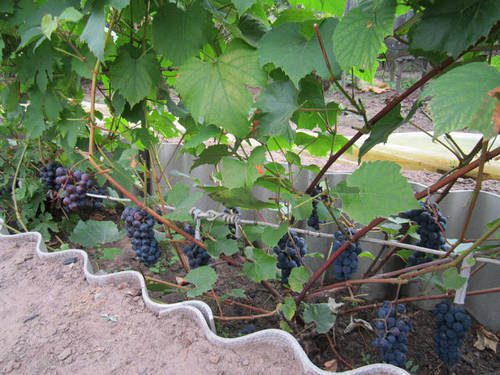
Katyr grapes produce good yields in harsh climates
To plant grapes and grow them in cold climates, you need to prepare a hole that will be a meter deep. Gravel is poured into the bottom of the pit, other material can be used, followed by organic fertilizers.
The soil that you dug out of the hole is mixed with fertilizers and sand, and returned to its original place. In order for the grapes to grow in the depression, a small part of the soil is removed. This will create convenience for warming the planted plant. Along the hill on which the seedling is placed, the roots should be straightened and sprinkled with soil. The final stage of planting is abundant watering.
You can place a pipe in the dug hole, which will provide a flow of water and oxygen to the root system of the plant. This action is carried out at will, but its effectiveness is so high that you should think about it and work hard to implement it.
The bottom of the excavated area is covered with a special material, where the bottom of the pipe is placed and the entire area is covered with stones; gravel will do. Further processing of the pit corresponds to the previous method. The pipe must be routed in such a way that it can be covered in cold weather.
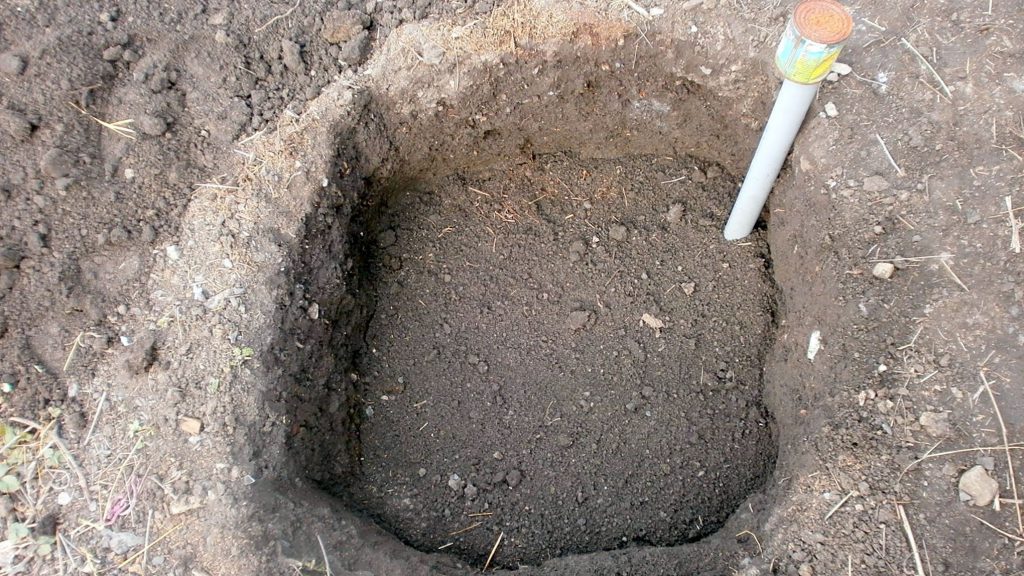
The pit for planting grapes can be equipped with a tube for the flow of water and air
Cleaning a vineyard bush
Due to the peculiarities of the climate of the Siberian region, the period and quality of pruning is carried out in a special manner. The vine is pruned twice, dividing the sequence of pruning the bush into a couple of times. The first cleaning of the vineyard begins in August and ends in September. This period is characterized by the harvest and the presence of green vegetation in the vineyard. Subject to removal:
- A vine that has already produced a harvest.
- Shoots characterized by weakness.
- Damaged branches and dry areas of the plant.
You need to leave those parts of the bush that create a replacement for the removed areas.
The second pruning is performed before covering the grapes for the winter. It is optimal to peel the grapes as late as possible to allow the plant to absorb maximum nutrients from the soil.
Spring is not suitable for pruning grapes in Siberia. In this region, springtime is accompanied by active sap flow and flowering.
Pruning is aimed at controlling the density of the grape bush. The fruiting vine is cut off completely, leaving a few shoots. One shoot is pruned more, the other less. When you grow grapes in Siberian latitudes, keep in mind that it is important to control the load on the bush. One bud is needed per eye for vegetative growth and yield; this is the optimal pruning of a grape bush.
During the first twelve months from the moment of planting, the grape bush grows and develops. The vine is formed and saturated nutrients. At the moment of fruiting, twenty eyes are left on the grapevine, from which future clusters will grow. In the second year of growth. The number of places for future clusters is doubled. Also done in the third year of growth. And in the fourth year from the moment the seedling is planted, the grapes should grow about eighty eyes.
By regulating the growth of the vine and the strength of the vineyard, the number of places for clusters can reach one hundred and fifty. If the grapes are small, then there should be a lot of eyes, and vice versa. The degree of workload of a grape bush depends on its endurance and strength.
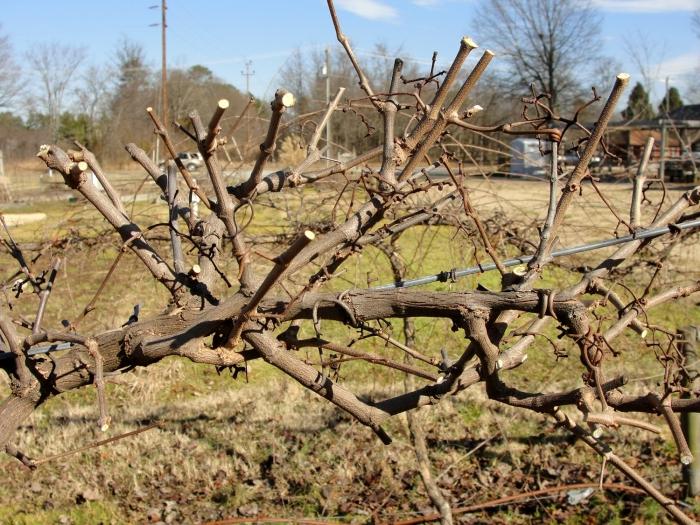
Grape pruning in Siberia is carried out in the fall
Features of caring for grapes on the site
To grow grapes in Siberia, you need to prepare the plant for the cold - harden it. Southern grape varieties should be grown in Siberia by beginners and experienced gardeners under insulating material. Since they can become a victim of temperature changes. Shelter is needed for young grapes and in unstable springs.
Over time, the grapes will become more resistant to climate changes and will calmly endure the winter. When caring for a vineyard in Siberia, it should be taken into account that planting material must be insulated for the winter. A huge role is played by feeding grapes and treating planting material with special preparations.
The cut sections of the grape vine are removed from the fastenings and laid along the area where it is planted. Dry bushes are subject to shelter. The climate for planting should be windy and warm. It is necessary to cover the grapes so that moisture does not enter the area at all. High humidity leads to illness. The vine is covered with a special material and sprinkled with earth on all sides. The grapes need to be sprinkled with plenty of snow so that the planting material is protected from excessive frost. If there is heavy snow, then you need to fence the vineyard from excessive rainfall. With the onset of spring, the upper part of the vineyard protection must be removed.
The insulation material is opened so that air can reach the planted material. In mid-spring, all shelter is removed, and greenhouse conditions are created for planting material until the period of probable frost ends.
For beginners, growing grapes in Siberia will not seem difficult if you consistently care for the plant.
Is it easy to grow sunberry grapes in Siberia? Sibling mothers share their advice.
Q: What grape varieties do you or your friends grow in our region?
A: Classic variety Aleshenkin. A variety with a seed, the taste is fresh and sour. But not everyone likes the taste. This variety cross-pollinates well with other varieties and is very frost-resistant. Therefore, if you are not afraid of bones, then I advise you. If you don’t like seeds, then it’s better to start with BCZ (seedless black winter-hardy). The variety ripens a little late. Very tasty. It is winter-hardy and, despite the books, produces large yields. The vine probably doesn’t read books and doesn’t know that it shouldn’t bear fruit well.
A: Variety Aleshenkin. We like it very much. Tasty and ripens well. But you have to cover it conscientiously.
O.: I have Aleshenkin, he is sick. I wouldn’t plant it now, there are much more interesting varieties. Tukay is in many ways similar to Alyoshenkin, but there are many differences for the better.
A: “Early white nutmeg”, I’m not thrilled with it yet. Smallish, sourish, it seems that our summer is not enough for it to ripen.
O.: Muromets. Also an old variety, but practically not sick, vigorous, very early, clusters up to 400g, black. Frost-resistant -26.
A: Variety Solovyova. I’ve had these grapes for 2 years, although I’ve been planting them in large bushes - I brought them from my mother from Altai. I kept it covered until the end of September to allow it to ripen. The yield from three bushes is 2 buckets.
A: Viking is beautiful, tasty, and the vine ripens perfectly.
A: I have Crimson, Tassone, and Harold growing. Very pleased.
A.: For the second year already, a new grape variety, HAROLD, has shown itself very well, it has a large berry, and taste, and most importantly, it is not capricious and the vines have excellent ripening.
A: Excellent varieties for Siberia: Kishmish, Radiant, Rusbol, Olga, Rusven, Golbena Nou, Tukay, Karmakod, Riddle of Sharova, Klyunevsky, Thumbelina, Siberian Cheryomushka, Lilac, Seedling Zolotukhina, Pinocchio, Savraska white.

Q: What yield can you expect?
A: A normal vine, with proper care, even in our climate, produces a minimum of 3-4 buckets. Well, there’s no point in tormenting the plant any other way. Why starve him to reduce the yield.
Q: Where can you buy grape cuttings in Novosibirsk?
A: I buy seedlings only at the Michurintsev Garden. Unlike Vaskhnilovskys, they always take root, they are large, and there is a good choice.
A: The simplest thing is to come to a meeting of the winegrowers club and buy sprouted chibouks there with roots. I buy from club representatives at the central market on Fridays. Or also from club representatives at spring fairs, at the Siberian fair or at the Stroiteley Palace of Culture (where the gardening club holds fairs). You can also buy it at the Chkalov House of Culture. Gardeners of Russia also have good cuttings.
Q: What should the seedlings look like?
A: A first-year chubuk (a seedling of the current year in February-May) is a stick sticking out of plastic bottle with 1-2 shoots, on which there are 2-3 leaves, but a bunch of roots (they are visible, because the plastic is transparent). Anything larger will take root less well; if the container is smaller, then it is more likely that the trail will die in winter.
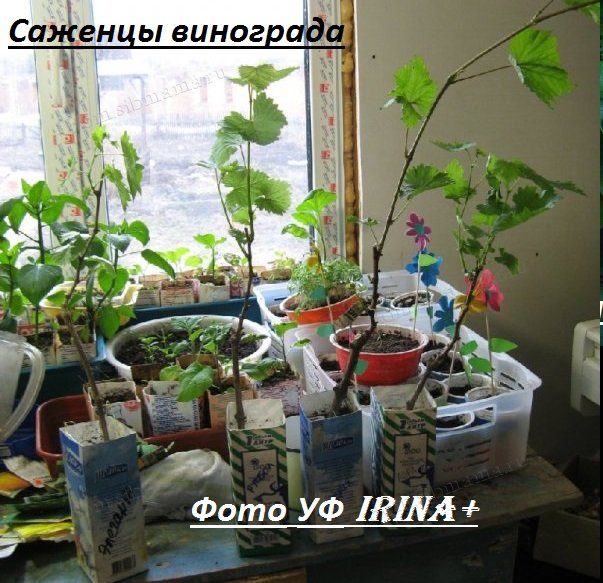
![]()
Q: When should I buy cuttings?
A: The best time to take cuttings is at the end of April - May.
Q: When are grapes planted?
A: It is best to plant it in early June.
A: In the spring, when the average daily t is established above + 10. Place the roots at a depth of 50 cm. In hot weather, plantings must be shaded.
Q: Is it possible to grow grapes from seeds?
A.: Regarding growing from seeds, I was told at Michurintsev that it is possible, only the berries will appear in 5 years. But a seed grown immediately in harsh conditions produces a seemingly stable seedling.
A: You can grow very high-quality virgin grapes from seeds. He doesn't give delicious fruits, but from it good wine and jam. Varietals can, of course, also be made from seeds, but it’s just a pain and a toss up, because To maintain a variety, you need to take seeds from reliable sources.
A: You can grow it, but if you are not going to create new varieties, it’s not worth it. The result is unpredictable.
Q: How many square meters are needed per plant?
A: There should be at least 2 meters between bushes. In fact, this is not enough, but we do not have industrial cultivation and we can fertilize more.
Q: In what soil should grapes be planted?
A: The main thing is that the soil in the planting hole is loose and water + nutrients do not stagnate there. It is best to put some stones at the bottom; it would be very good to add sand (this is practically its natural soil).
A: Every year, an adult grape bush grows up to 50 huge vines, and even produces a harvest, so it needs increased nutrition. The soil should be rich in humus and, for the roots to breathe, breathable, without stagnant water.
Q: How to prepare a hole for planting grapes?
A: For me, the most difficult thing in growing is preparing the planting hole before planting. When I did this for the first time, the whole garden cooperative laughed, because... on the May holidays, instead of sowing vegetables, I spent 2 days digging holes. People walked around and pointed, and next year also came and pointed to the grapes. The hole is dug 80-100 cm deep. Then 10 cm of drainage is poured in order - I poured medium gravel, stones are possible, bricks are not recommended, because... crumble over time, but expanded clay can.
Then we pour 50 cm of special soil (how to prepare it - later) for planting. Now in the poured soil we make a hole 40 cm deep. Not by throwing the earth out of the hole itself, but by pushing it up and towards the edges (you have 20 cm of reserve left on top, so this will work out easily). It turns out that your drainage is covered with about 10-20 cm of soil. On top of this, place the chibouk in the resulting hole. You need to remove it carefully, because... The roots there are young and the vine is fragile. It's easier to cut the can. Place the chibouk and before the first bud wakes up, fill it with new special. earth.
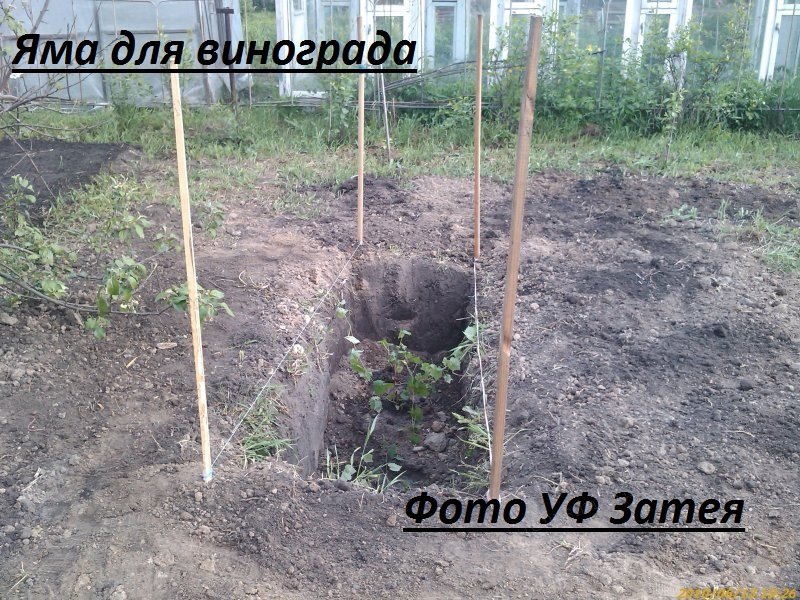
![]()
Q: How to strengthen a hole for grapes and why is this necessary?
A: After pouring drainage and before pouring soil, I recommend strengthening the edges of the pit (sidewall). The reinforcement may be shaky and fragile. Its main task is to ensure that it doesn’t crumble too much for 2 years and that weeds don’t grow.
A: Preparation of planting holes. The planting step is 2 m-2.5 m. Bushes are planted either in separate planting holes with a diameter of 80-100 cm, or in a continuous trench of the same depth and width. Drainage is laid at the bottom of the trench - 10 cm. On top is soil with the addition of humus or compost, 300g of wood ash, 200g of superphosphate. In dense soils, you need to add a loosening material. Then pour water over everything. The hole is not completely filled; the remaining 20 cm will be used for winter shelter. The edges are strengthened with a trench.
Q: What is the pit for?
A: 1. So that the growing season begins earlier.
2. To have more space for roots. Let me explain point 2. The root system of the grapes is located 10-15 cm from the surface of the earth, over an area of approximately 4 meters around the perimeter of the bush. Because our garden plots do not allow us to allocate such an area only for grapes; we force the roots to grow along the horizontal and vertical surface of the earth, thus using the hole to increase the area.
3. For the first year of winter, all the vines are placed in this hole; in the second and subsequent years, the main part of the vine is placed in the hole, and the remainder, which is not a pity, is placed on the ground around.
Q: Is it necessary to plant grapes in a hole?
A.: It is not necessary to plant in holes, you can just in the ground, but bury the hard part of the stem to the very buds, from which the branches begin. Personally, I don’t bother with ditches anymore and I’ll add more soil to the bushes that I have.
Q: How to plant grapes if groundwater is close?
A: It is unnecessary to dig a trench for grapes there, since the roots are likely to become soaked and constantly be in the cold. On the contrary, I added soil under my grapes, lifting them up. It’s a shame that they did such a job, because a trench depth of 25-30 cm would have been quite enough to cover the vines.
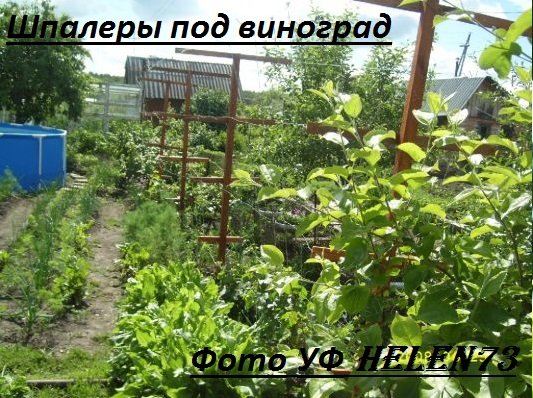
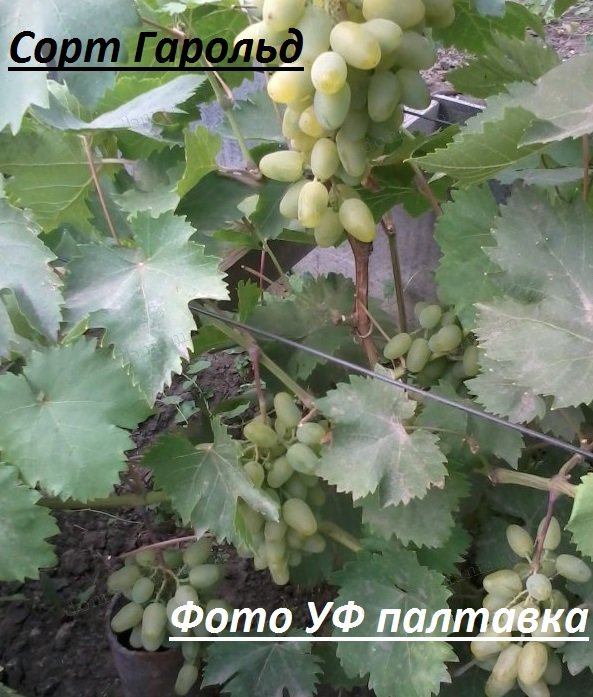
Q: What options are there for planting grapes?
A: If you plant grapes from north to south (a trench for planting several varieties is dug in this direction), then they are well illuminated by the sun during the day, but then they will have to be raised onto a trellis in 1 row. If you plant it from west to east, then it is convenient to make it on 2 trellises, and then it is not necessary to dig a tunnel, and it can easily be placed in planting holes, but they must be wider than in the first case. In general, the second case takes up less space, and now it sits like this on the site, but I personally like the first option more in terms of its beauty and ease of care. And on my plot, as soon as I have a large amount of land, there are plans to set aside 4 acres for a vineyard, so there I can afford to grow grapes using the first method. The first method allows you to harvest large harvests, although the question arises whether this is necessary. Our family cannot cope with these harvests either.
Q: Is it possible to let it grow upward (will it be possible to remove it from this position for shelter)? For example, plant it near the house and let it go towards the balcony?
A: Actually, grapes are a slope crop. He loves open, ventilated areas. Therefore, see for yourself where to plant. You can also do it near the house on the south side, but further away and point it towards the house with an arch, so that you create a tunnel. It is important that there is ventilation there. And take into account the freezing of the soil near the foundation of the house. My neighbor clogged a pipe to the roots of the grapes to improve aeration and watering. In the first year the growth was indeed higher, but winter almost destroyed the vine. I nursed her for him for 2 years. And this is 1 pipe, and then what can the foundation of the house do? My grapes sit along the fence in 1 row at a distance of 1.5 meters from the chain-link mesh and its posts. It is guided along a trellis with a slope towards the chain-link. As a result, it still turns out to be a jungle. We plant early potatoes, sunflowers and peas there. Peas and other legumes next to grapes are generally useful and pleasant - one complements the other. When we plant potatoes, the grapes receive additional aeration and fertilizer. But the sunflower is good only as supports, but it devastates the soil greatly, so you have to fertilize it. But it is convenient to cover grapes with sunflowers and corn for the winter.
Q: How should grapes be watered?
A: During the first days, watering is required as the soil dries out (approximately every 2-3 days). Grapes are a moisture-loving plant. But the main thing is that there is no stagnation of water.
Q: How are grapes fertilized?
A.: 1st feeding with chemicals: 20 g nitrogen + 30 g complex fertilizers per. 10 liters of water; 2nd feeding - organic, that is, 1.5 liters of mullein or 0.7 liters of chicken manure per 10 liters of water; The 3rd and 5th feedings are similar to the first; The 4th and 6th are similar to the second. In addition to root fertilizing, with the appearance of leaves, apply 2-3 foliar fertilizings with nitrogen: 50 g per 10 liters of water and spray the bushes. From August 1, continue fertilizing, but exclude nitrogen fertilizers, i.e. For 10 liters of water, give 30 g of phosphorus and potassium salts, exclude organic matter. Since the growth of shoots (vines) will already be sufficient, and the purpose of fertilizing is to achieve maximum ripening of the vine, you can use wood ash extract.

